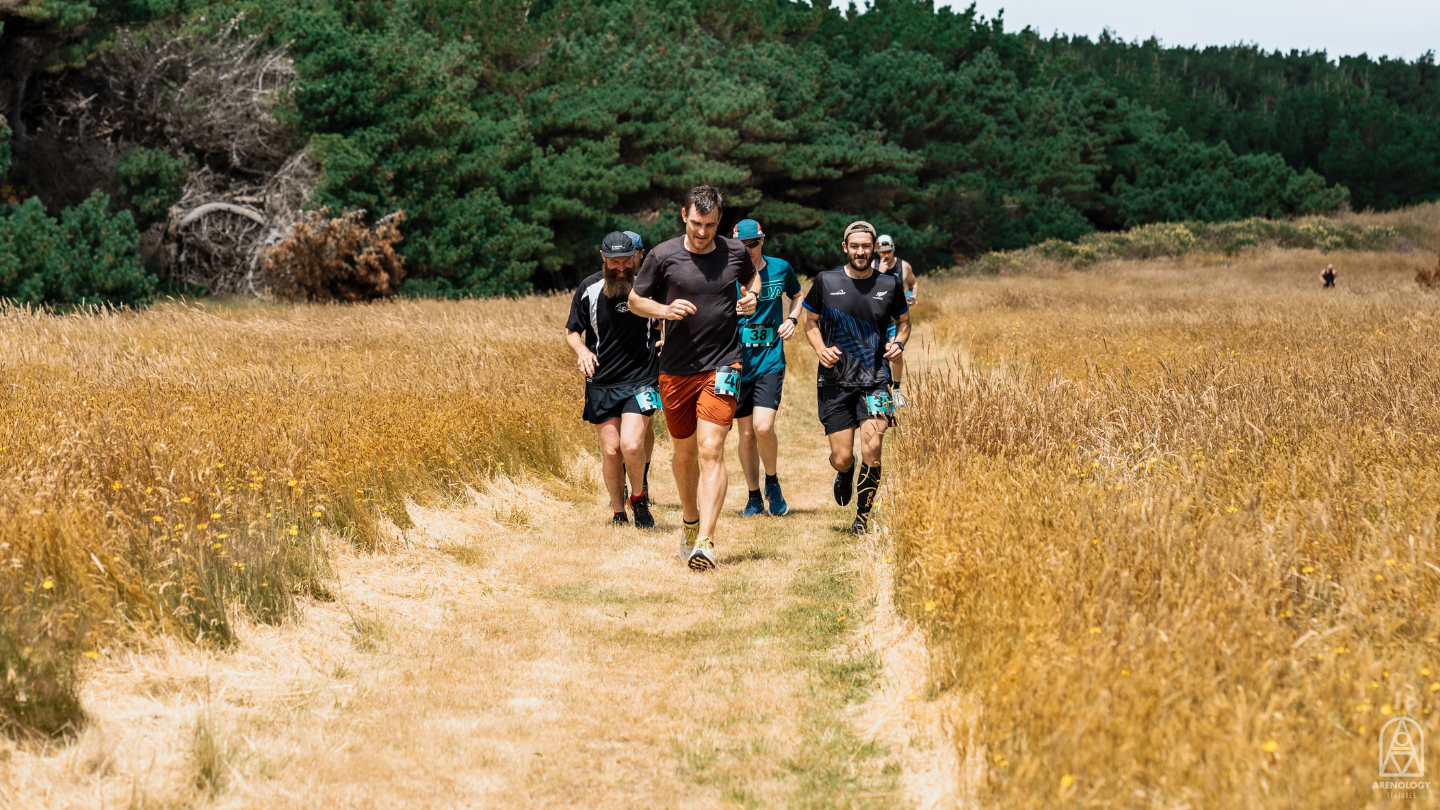
This year, Australian trail runner Lucy Clark, 34, turned heads when she recorded the fastest-known time on the Te Araroa, a 3,000km trail that snakes the entire length of New Zealand from Cape Reinga, the northernmost tip, all the way down to Bluff in the South Island. NICKI LETTS joined Lucy for part of her astounding feat.
A few weeks after finishing her record-breaking run of the Te Araroa (TA) in January, Lucy Clark could barely run 5km without her legs screaming to stop – not because she was injured, but because her body had nothing more to give after her record 66-day sprint along the 3,000km trail.
“I’m just really, really tired,” Lucy said. “It’s incredible to think that only three weeks ago, I was running 50km – sometimes more – every day. Now my legs don’t have any power. I wake up tired and am ready for bed by lunchtime.”
Before January, there wasn’t a reason why you would have heard of Lucy Clark. But in setting the female fastest-known time, or “FKT”, on New Zealand’s only thru-hike, she has become a trail-running celebrity. Completing the run in 66 days, 7 hours and 8 minutes, she shaved 11 days off the existing record, which was set by New Zealander Mina Holder in 2015.
Lucy has been running for 35 days and clocked 1,747km by the time my partner Mat and I join her on the Queen Charlotte Track on the northernmost tip of New Zealand’s South Island. Our mission is to pace her for 10 days through arguably the toughest sections of trail: the Richmond Alpine Track and Nelson Lakes. We are under no illusions that this is a holiday. For the past few weeks, Lucy’s husband and support crew chief, Tom Wright, has been messaging us with updates and instructions. This run is their life.
Mat and I arrive in the port town of Picton by bus and start scanning the carpark for the bright green campervan. From her first step on the trail, Tom has made sure he and the van are at every conceivable spot for Lucy, providing her with meals, logistical support, massages, a change of shoes (nine pairs of Hoka One One runners), and, most importantly, a bed.
We find Tom inside the van, hunched over his laptop. Camera equipment, Clif Bars, open chip packets and coffee-stained cups are strewn across the table. He spots us and grins broadly, rushing out to wrap us in a big bear hug. It’s been six weeks since we’ve seen Tom, and, to be honest, he’s seen better days. His usually manicured beard is overgrown and scraggly. Dark circles have made a home under his eyes. He looks like he hasn’t slept properly for, well, six weeks. Despite appearances, he quickly switches to uber-enthusiastic crew mode, showing us where to put our bags and pouring us a black coffee (“Sorry, I need to pick up more milk!” he apologises), while checking the tracker app for his wife’s progress.
“It looks like she’s about halfway, so we’d better make a move. It’ll take over an hour to drive to the campsite.” Lucy’s running 59km today – a feat of endurance that’s become normal over the past month. We’re eager to surprise her on the trail and run in the last few kilometres.
As the van snakes around the roads of the Marlborough Sounds, Tom regales us with stories of the past month. Until now, we’ve been obsessively following Lucy’s progress on Instagram, but the upbeat posts filled with impossibly stunning landscapes and funny emojis don’t tell the whole story. Like Lucy, we are diving into the unknown.
***
A few months ago, Lucy would not have described herself as an ultrarunner. Two years ago, she wouldn’t have described herself as a trail runner. She was a road runner. A fast one. When we met in 2018, she was training to crack 3 hours, 10 minutes at the Melbourne Marathon. She and Tom had moved from Melbourne to Bright, a running and cycling mecca in the Victorian Alps of Australia, just months before. But rather than hitting the mountain trails with new friends every weekend, she was running intervals along the concrete bike path.
That all-in attitude defines everything Lucy does. There’s a quiet determination – a silent push for perfection – that drives her. So, when she heard about the Te Araroa, just running it would never be enough. She wanted to be the fastest. Without realising, she was pulled into the endurance world’s latest obsession: FKTs. Since Kilian Jornet set the speed record on Kilimanjaro in 2010 (a 7-hour, 14-minute round-trip), pursuing FKTs on iconic and not-so-iconic trails has become a rite of passage among ultra-endurance athletes. Lucy wasn’t yet an ultra-endurance athlete, but that wasn’t about to stop her.
She started reading everything she could find about the trail. She reached out to the record holder, Mina Holder. And she and Tom spent evening after evening nutting out the logistics. This was where things got tricky. Opened in 2011, the Te Araroa is touted as New Zealand’s answer to the Pacific Crest Trail and Appalachian Trail, but with one major difference: it has no dedicated trail. “The Long Pathway” is, in fact, a hodgepodge of farmland, beaches, road, coastal track, highways and mountain trails. It winds through cities, towns and remote wilderness. It’s every support crew’s nightmare. But the more Lucy researched, the more determined she became. By January 2019, the decision was made: Lucy was going to break the female FKT.
But they knew she couldn’t do it alone. If she was serious about breaking the record (77 days, 10 hours and 44 minutes), she needed to average over a marathon a day for 70 days. And to do that, she needed a coach. The first coach Lucy reached out to told her she was getting in over her head. He said she wasn’t experienced enough and perhaps a better goal would be just to finish the trail – not attempt the FKT.
It was a huge blow. Lucy had just raced her first-ever ultra, the Two Bays Trail Run 56km in Victoria, and placed sixth female. But now she was deflated. Doubt crept in. Was she reaching too high? Maybe the coach was right. Maybe she didn’t have enough experience to attempt something so ambitious.
Then she heard about Andy DuBois. Andy is one of the world’s top endurance coaches, and an ultra-athlete himself. Lucy took a deep breath and sent him a message. Andy’s reply said everything she needed to hear: “OK, so FKT of Te Araroa – awesome goal.”
With Andy in her corner, she threw herself into a gruelling training schedule. “It’s not really about speed. It’s more about building endurance and, even more importantly, building resilience – both mentally and physically,” Andy told me. Lucy would back up midweek interval sessions with hill repeats on Mystic, the mountain that quite literally sprouts from her backyard, then spend the whole weekend on the trails. Friends would meet her for a four-hour run and a coffee, only for her to run for another two hours after we’d left. When Tom decided to run the Melbourne Marathon (which he finished with a PB), Lucy signed up as an official pacer. This was less than one month before her FKT attempt. And all the while she had a full-time job, which required her to commute from the mountains to Melbourne every fortnight.
“I still didn’t miss a single session of training. Sure, sometimes I didn’t quite hit my paces, but I completed every session,” Lucy said. “I just figured that, in New Zealand, there would be crap days and there would be good days. So, every crap day in training was good training for the TA.”
This was put to the test quicker than she’d have liked. The first day of the challenge was a disaster. “I was really emotional at the start, obviously. Then I had to run 70km along a beach – the furthest I’d ever run in one day, and it was all on sand. Tom planned to meet me at the 40km mark for lunch, but I got to the campground and he wasn’t there. Luckily, I had one bar of signal and saw he’d messaged to tell me to keep going and not worry. So, I kept going, not sure when he’d meet me. Finally, he ran towards me. It turns out the road to the campground was closed, so he had to hitch a lift and run 10km along the beach to find me.” Reunited, they battled the headwind, Lucy sheltering behind Tom like a pro cyclist, their pace barely a shuffle.
“That night, I was totally wrecked. I tried to roll my muscles and eat something, but I was a mess. I also had blisters between my toes, which I’d never got in training. Andy messaged me and said, ‘Great, day one is over. Now you just need to get through the first week.’ But I’m thinking, I’ve got 69 more days of this! I don’t ever want to do that again; how will I do it for 69 more days?”
The next morning, Lucy ignored the anxious knot gnawing at her stomach and tried to be positive. Then she ran another 30km on the beach, followed by a punishing 26km on a state highway. “It was pretty soul destroying and there were more tears,” she groaned. “But I’d been told it takes about eight days for the body to adapt, so I knew I just needed to stick it out.”
Every morning of the first week was the same. She’d wake up in tears. Tom would console her, help her get ready, try to find encouraging words, then watch his wife run off into the distance. “It was so hard for him. But the whole time, I would tell Tom, ‘I want you to know that I don’t want to quit. I’ve worked so hard for this. It just sucks right now, but I don’t want to quit.’”
Then, right on schedule, on day eight, something shifted. Lucy started feeling like she was having fun. “Suddenly, I felt strong. I was able to eat more food and was moving way faster than expected. It was a lightbulb moment. I felt like I could do this, and I wanted to do this.”
That was the first day she didn’t cry.
***

Tom steers the campervan into a small, grassy campsite. Swatting flies, we quickly agree on a plan: we’ll head up and meet Lucy and run back to the van in time for dinner. He warns us, semi-seriously, that Lucy now only eats, runs and sleeps. This isn’t a trip for late-night chats over beers. We head up onto the Queen Charlotte Track to find her, and we’re not waiting long before she shuffles into view.
Lucy is slight and wiry, like a track athlete. She’s lost the muscle definition of mountain legs, which are now swimming in her tights. Her blonde hair is tucked under a Bright Brewery cap and she’s got the burnished complexion of weeks spent in the harsh sun. “Oh my god, I’m so happy to see you guys! I knew I’d see you soon, but I didn’t know when!” she squeals, taking out her earphones.
Running 5km back to the campsite flies by as we chat excitedly about the trails and our adventures to come. But back at the van, it isn’t long before we glimpse something new in Lucy. Something we hadn’t seen in her year of training: anxiety. Tommy spurs into action, heating pasta and sauce, putting bags of chips in front of Lucy, unrolling the stretching mat, and taking photos. But Lucy is oblivious. She’s hunched over the trail notes, checking the spreadsheet on her phone, and then rechecking the notes.
“I thought we could do the Richmond Ranges in four days, but what do you think? Is it too hard? Will we need an extra night?” She’s already hiked across the Tongariro Crossing in thick fog and gale-force winds, kayaked along the Whanganui River and got lost in the Tararua Ranges. Amazingly, she’s still nervous about what the South Island will bring.
Everyone has warned her this is the toughest part of the whole trail, and it’s been playing on her mind for days. The weather forecast doesn’t help. The Richmond Ranges has lots of river crossings, and the slightest downpour can cause the rivers to rise and become unpassable, which would jeopardise her meticulously planned schedule. We play out a few scenarios but eventually decide to leave the plan as is.
Early the next morning, I set off with Lucy for the last 15km of the Queen Charlotte Track. Mat swaps in for the next 40km along road and across farmland, while Tom and I mission to Nelson to buy her a new rain jacket. It’s a four-hour round trip. “We’ve got rain jackets, but she wants a better one just in case,” he shrugs. “If it makes her feel more confident going into the ranges, it’s worth the money.”
This is what Tom does. His every waking moment is dedicated to supporting Lucy. “He did literally everything for 66 days,” she told me at the end. “Washing, logistics, communications, cooking, shopping, filming. He was my masseuse and counsellor. He put his life on hold for months so I could do this, and I know there’s no way I could have done it without him.”
The raincoat was a wise purchase. Two days later, we head into the Mt Richmond Forest Park in torrential rain. Tom drops us at the point where Lucy had finished the day before. When I look across at her in the backseat, her face is fraught and she’s picking at her nails agitatedly. But as soon as we wave goodbye to Tom and start running, the mood switches. The anxiety of the past few days is gone, as if it was never there. Lucy is chatty and relaxed. She moves with real purpose, pushing forward with every step. Her stride is long and even, her poles swoop the ground. Meanwhile, I’m tripping over slippery roots in a desperate bid to keep pace. It’s becoming clear that, no matter how Mat and I are feeling, we have to suck it up and suffer through – there is no way we will be the reason she fails.
I learn something very quickly over the next few days: food is everything. Lucy has undoubtedly lost weight since starting her run, but it is not from lack of eating. She inhales packet after packet of Clif Bloks like they are air. The tell-tale rustle of a wrapper is our signal to refuel. If Lucy is eating, we need to eat, too. “Food is fuel,” she instructs us in a mock teacher voice. “I don’t even think about whether I like what I’m eating anymore; I just eat as much as I can.”
Good job we’ve packed so much food, then. Salamis, wraps, cheese, Clif Bars, nuts and chocolate are squeezed into the gaps between my thermals, sleeping bag, inflatable mat and a change of clothes. We’ve rejected tents in favour of sleeping in the huts no matter what. If all the bunks are taken, we will sleep on the floor. This is the only way we can travel superlight – essential when it comes to shattering a record.
In the huts at night, while Mat and I share salami wraps and a block of Whittaker’s chocolate, Lucy ploughs through peanut butter wraps, salami, chocolate, cheese and muesli. After dinner, while Mat and I laze on our bunks, she methodically stretches, rolls and massages from glutes to feet, all while cheerfully answering the same questions by inquisitive hikers with a patience that astounds me.
“Oh wow, you’re Lucy!” an English hiker gushes as we open the door to one hut. “I’m following you on Instagram. What you’re doing is amazing!” She hurries to make us all a cup of tea, which Mat and I are only too happy to accept, despite not being Insta-famous. Generosity like this is something Lucy has experienced from day one. Strangers have opened their homes, given them rides, run with Lucy, and offered icy drinks from car windows on hot days.
On day three, I watch as Lucy scrambles up a scree slope, singing, “Ain’t no mountain high enough,” through laboured breath. We’ve hiked and run for more than 90km, gaining 2,000m of vert each day. But this is our toughest push yet. Five hours criss-crossing the roaring Wairoa River drains our mental strength. Our legs are wasted and I’m more than ready to bunk down in the next hut. We reach Top Wairoa Hut two hours later than planned and find a couple of German hikers stoking a fire. Mat and I nibble on some peanuts, secretly hoping Lucy will take her bag off – the signal that we’re done for the day. But to my alarm, she wolfs down a cheese wrap and hustles us out the door. It’s 5.30pm. Four hours and a rainstorm later, we’re where she wants us to be. As I fall onto my bunk and listen to Lucy chat away to some hikers, I think, “She’s actually going to do this. She’s going to break the record.”
The next afternoon, we emerge from the Richmond Ranges. The last 20km to the trailhead is a slog through flooded paddocks before winding down a tedious fire trail. Mat has been suffering from painful shins since day two, so he drops back as Lucy and I power on. By 4pm, we are desperate for the van. Conversation dries up and Lucy’s energy is dangerously low. Miscalculating our arrival time led her to break her own rule: she didn’t eat for two hours. It’s a mistake you only make once.
I feel a bit like I’m hallucinating when the green van pops out of the trees and Tom bounces towards us, full of energy we wish we had. We collapse into camp chairs on the roadside, happy for him to fuss over us. He presents our favourite foods – a chocolate muffin for me, Doritos for Mat, a chocolate milkshake for Lucy – and chitchats happily about his past few days.
But the section isn’t over. The trail notes dictate another 8km along the road into the lakeside village of Saint Arnaud. Exhausted and uninspired by the idea of running on concrete, Mat and I offer to take the van so Tom can run with Lucy. The FKT rules command that she must cover every section of the trail by foot (except for a couple of pre-approved river sections).
“Let’s just get this done,” she says, shedding her multi-day pack and switching to a Nathan vest and Hoka Rincon road shoes.
More than an hour later, they find us in the hostel. Lucy hobbles to the shower, Tom and Mat organise the laundry (and beer), and I stare blankly at my bag. We have 12 hours before hitting the trail again for another three days of running. There is no time to reminisce over the journey we’ve just taken through the mountains. The app and trail notes come out, plans are made, bags are packed, and by 8am the next morning, we are ready to do it all again.
That’s the thing about an FKT – there’s no time to sit still. Lucy is constantly thinking about ways to shave a few more hours off a day, a few more days off the record. We march into the Nelson Lakes with a mission to be over the Waiau Pass (the second-highest point on the TA at 1870m) and out the other side by Christmas Eve. That gives us three days and two nights. Most hikers complete this section in eight days.
As we settle into a rhythm, we talk about Lucy’s mental struggles on the trail. How is she managing the anxiety that storms in whenever she stops moving?
“I just have to remind myself that you can’t get caught up worrying about things that haven’t happened yet,” she says.
“Sure, there are going to be some really scary river crossings, and there are nights after you’ve gone when I will be staying in a hut by myself in the middle of nowhere. And to say I’m scared about those things is an understatement. I just don’t know if I can do it by myself.
“But right now, there’s no point worrying about that. I need to focus on being here and completing this section as strong as I can.”
Her words remind me of a note taped inside their van, something her mum told her before the trip. It reads: “Eat the elephant one bite at a time.”
On our second day in the Nelson Lakes, we reach a section where huge chunks of track have been washed away by flood waters. For 2km, Lucy crashes through a wall of thick bushes and undergrowth, as though every tree stands in the way of her record. Her determination is palpable.
We run for 16 hours that day. And we make it back to the support van in time for Christmas. It’s her only full day’s rest on the whole trail.
It’s also our last day with Lucy and Tom before we fly home. But as we drink beers and play silly games, her mind is already running on the trail. Lucy is about to set off solo for the next three nights, which means tackling her biggest fears: crossing rivers, staying in huts by herself, loneliness. As we hug goodbye, Lucy is crying. “I know you can do this,” I tell her honestly.
Her eyes lock with mine. “I know I can, too.”
Lucy’s FKT was supported by Clif Bar, Hoka One One, Nathan Sports, Bright Brewery, Bright Physiotherapy and Soek Sunglasses.
This article featured in Edition 35 of Trail Run Mag.






